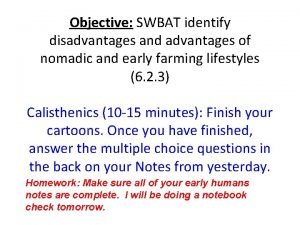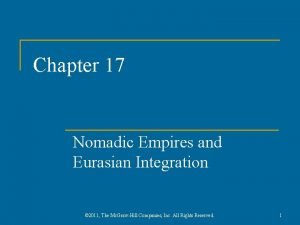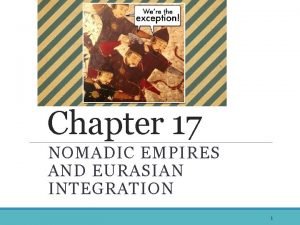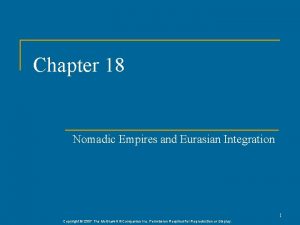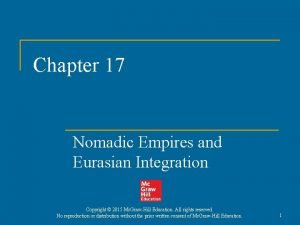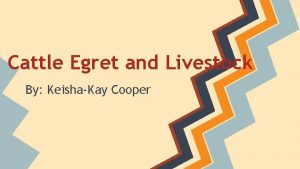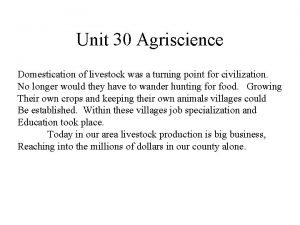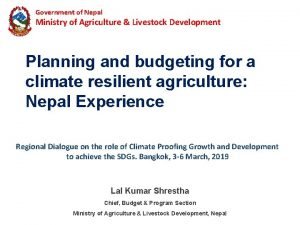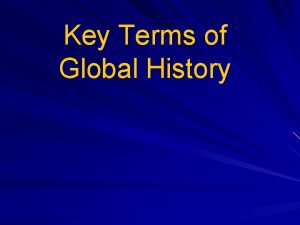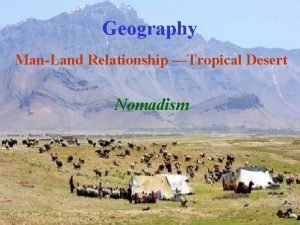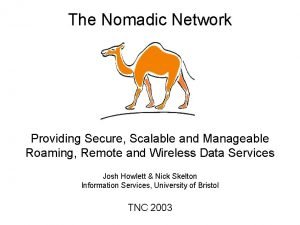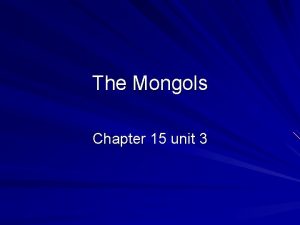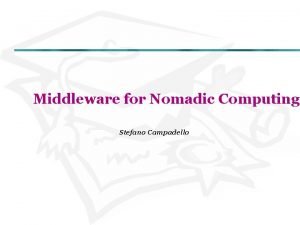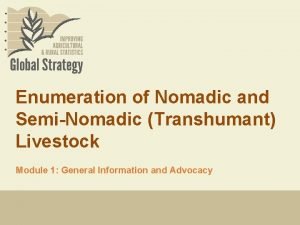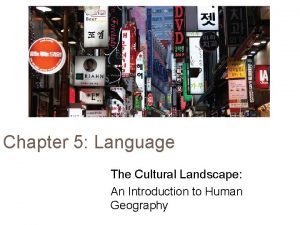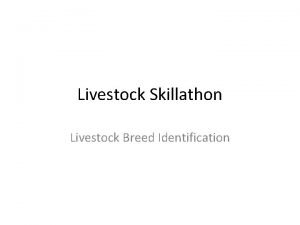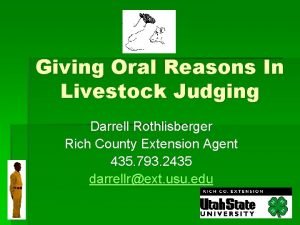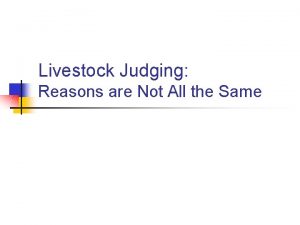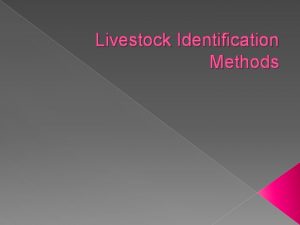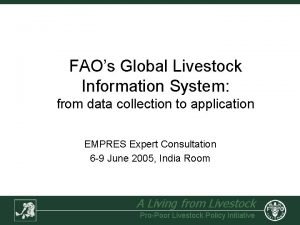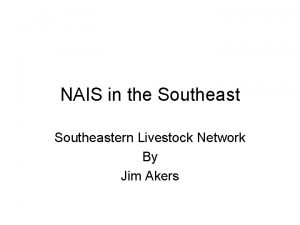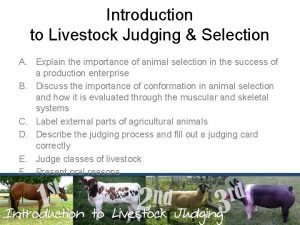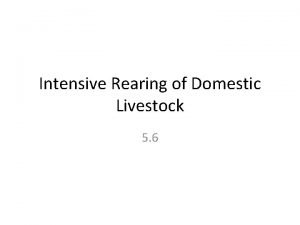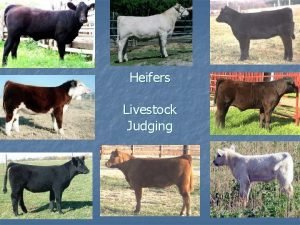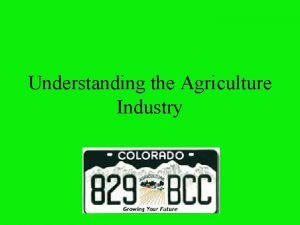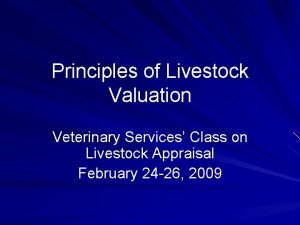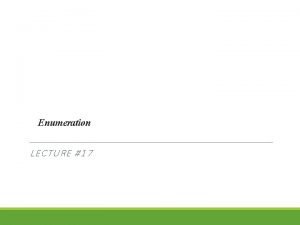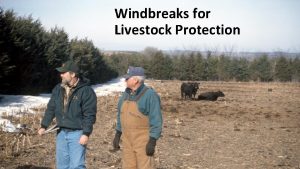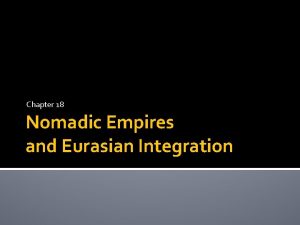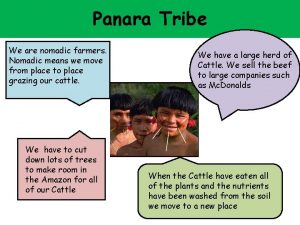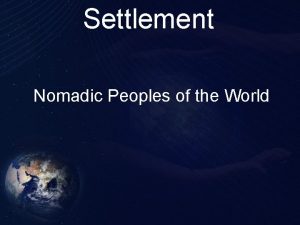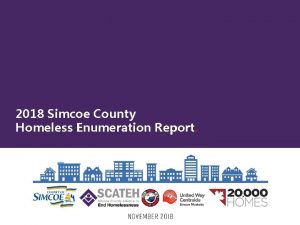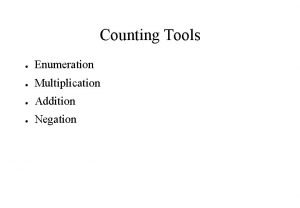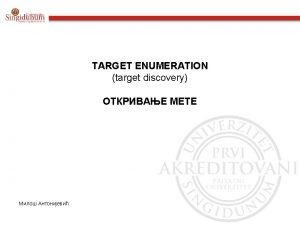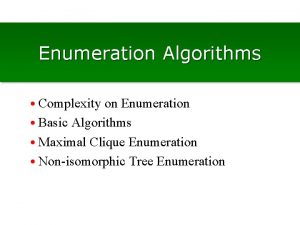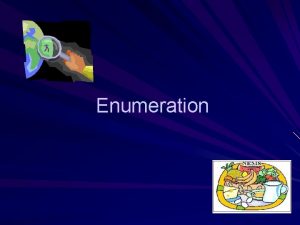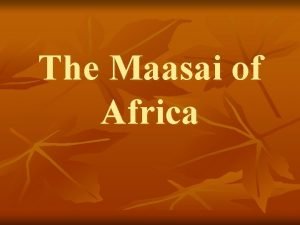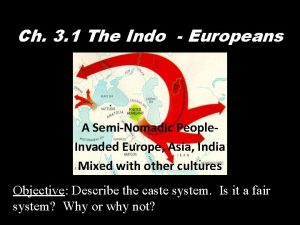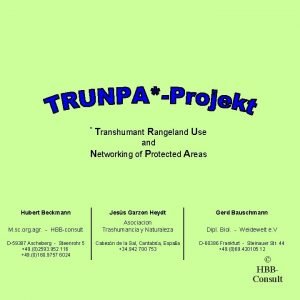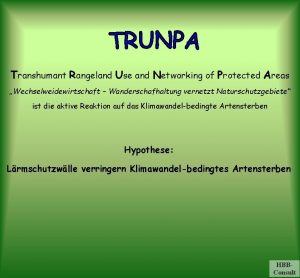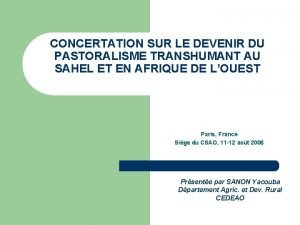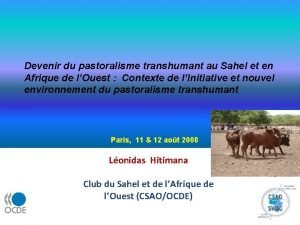Enumeration of Nomadic and SemiNomadic Transhumant Livestock Module






































- Slides: 38

Enumeration of Nomadic and Semi-Nomadic (Transhumant) Livestock Module 1: General Information and Advocacy

Introduction • Nomadic livestock in arid and semi-arid areas is widely practiced and of great importance • Guidelines on collecting livestock data are over 20 years since publication by FAO in 1992 • There has been revived interest in nomadic livestock statistics • • ü awareness of importance of livestock production in rural economies and wealth generation ü need to assess livestock production impact on environment ü pressing demand for quality cost effective data for policy formulation ü pressing demand for quality cost effective data for monitoring and evaluation of SDGs Revived interest is also based on ü emergence of new methods of assessing livestock resources and production parameters ü GPS and drone technology for geo-referencing, recording data also technology and computing capacity for entering, checking, analysing and displaying data. Enumeration of nomadic and semi nomadic (transhumant) livestock is demanding methodologically ü mobility of livestock and livestock holders complicates the undertaking ü difficulty in of reaching target population, Possibility of double counting, difficulty in building sample frame etc. • Thus there is need for technical capacity at country level to secure collection and compilation of quality statistics in cost effective way • Global Strategy has revised and updated FAO 1992 guidelines to reflect new methods and technologies • GS has also prepared this training material to build capacity to enumerate nomadic and semi-nomadic livestock 2

Targeted Audience for Training in Enumeration of Nomadic and Semi-Nomadic (Transhumant) Livestock Agric. Ministry Training ItemAudience Definitions of Nomadic & Semi-Nomadic Livestock 1. Keeping NSO Top Technical Top Management Staff Management Survey Managers/ Supervisors Training & Research Centers Researchers, Technical/ Teaching Staff & Analytical Staff Students √ √ √ Rationale/Why Enumerate 2. Nomadic & Semi-Nomadic Livestock √ √ √ Methods to Enumerate 3. Nomadic & Semi-Nomadic Livestock √ √ √ Integrating Enumeration of Nomadic & Semi-Nomadic 4. livestock into Main Stream Agric. Survey √ √ √ 5. Survey Designs & Estimators × √ √ √ 3

Expected outcomes of training • After training, participants will be expected to be able to: ü Understand concepts and methods used in collection and compilation of nomadic and semi nomadic livestock data ü Identify and apply appropriate methods to collect and compile indicators for nomadic and semi nomadic livestock ü Improve data quality through selection of and use of appropriate sample surveys design for nomadic and semi nomadic livestock • Sustain gained technical capacity through continuous selflearning using Global Strategy knowledge resources available online also through peer to peer knowledge transfer 4

Module 1: Objectives Presentations of module 1 will… • Introduce the concept of nomadic and semi-nomadic (transhumant) livestock • Inform the audience WHY enumerate nomadic and semi-nomadic (transhumant) livestock • Present recommended approach for integrating enumeration of nomadic and semi-nomadic (transhumant) livestock into mainstream Agricultural Survey Framework • Provide some general recommendations for the enumeration of nomadic and semi-nomadic (transhumant) livestock 5

Presentation Outline 1. Definition of nomadism and semi-nomadism (transhumance) 2. WHY enumerate nomadic and semi-nomadic (transhumant) livestock 3. Integrating enumeration of nomadic and seminomadic (transhumant) livestock into mainstream Agricultural Survey Framework 4. General Recommendations for the enumeration of nomadic and semi-nomadic (transhumant) livestock 6

1 Definition of Nomadic & Semi. Nomadic Livestock 7

1. 1 Introduction • Old & new definitions for Nomadic Livestock production exists • Previous definitions based on FAO (1992) guidelines on collecting livestock data • According to FAO’s previous guidelines: − A nomad “is identified not as belonging to a particular locality, province or other delimited territory but belonging to a tribe which is a group of nomadic people usually having the same ancestral origin. ” − Nomadism “is broadly defined as a movement of tribes or clans and/or herd keepers with their herds. ” • Definitions from FAO (1992) guidelines are not satisfactory to present situation hence have been updated 8

1. 1 Introduction (cont’d) Current Definitions… • Based on “Pastoralism” “husbandry of grazing animals and the use of naturally occurring fodder resources for the production of livestock and maintenance of livelihoods. ” • Blench (2001) describes three main forms of pastoralism: agro-pastoralism, nomadism and transhumance 9

1. 2 Agro-Pastoralism, Agro. Pastoralists & Agro-Pastoral Livestock Agro-Pastoralist & Agro-Pastoral Livestock − Agro-pastoralists are permanently settled and the movement of agropastoral livestock is local, irregular and very limited. − Livelihoods of agro-pastoralists depend on both livestock and crops, with livestock being an important but not necessarily the major contributor to household livelihoods. − Animals generate cash, food, insurance, manure, transport and hauling services, savings, and other goods and services for the household. − Possible when livestock herds of agro pastoral households become large, are sent away for grazing with more nomadic pastoralists 10

1. 3 Nomadism, Nomadic Pastoralists & Nomadic Livestock Nomadism − The Oxford English Dictionary (11 th edition) defines the terms “nomad”, “nomadic” and “nomadism” as relating to people who travel from place to find fresh pasture for their animals Sampling and have no permanent home FRAME − According to Blench (2001), nomads are exclusive livestock producers, who grow no crops and depend solely on the sale or exchange of animals and their products to obtain foodstuffs. Their movements are opportunistic and follow pasture and water resources in a pattern that varies from year to year. 11

1. 3 Nomadism, Nomadic Pastoralists & Nomadic Livestock (cont’d) Nomadic pastoralists and nomadic livestock: − Nomadic pastoralists are not permanently settled and the movements of nomadic livestock are irregular, erratic, and long distance. − Pattern of movement depends on availability of forage resources; − Livelihoods of nomadic pastoralists depend almost entirely on livestock. 12

1. 4 Transhumance Transhumant pastoralists and transhumant livestock − The term “transhumant” in recent decades, is more used in place of the term “semi-nomadic”, meaning partially nomadic − Transhumant pastoralists are not permanently settled, although they are usually settled for a part of the year. − Movements of transhumant livestock are regular, cyclical and short-distance. − Livelihoods of transhumant pastoralists depend largely on livestock 13

1. 4 Transhumance (cont’d) According to Blench (2001), … − “transhumant pastoralists often have a permanent homestead and base at which the older members of the community remain throughout the year. • is often associated with the production of some crops, though primarily for herders’ own use rather than for the market. − In many temperate regions, where snow is likely to block animals’ access to pasture, haymaking is an important component of the system. 14

1. 4 Transhumance (cont’d) • Characteristic feature of transhumance is herd splitting ‒ Herders take most of the animals to search for grazing, but leave the resident community with a nucleus of lactating females. • Herd splitting practice may vary … − Improved modern transport in recent times allows households not to be split so radically; − Household members can travel easily between the two bases. − Whether milking females, weak animals or work animals are left behind depends substantially on the system being followed, and may vary within an individual system on a yearby-year basis. 15

1. 4 Transhumance (cont’d) • In other countries, large scale transhumance systems co-exists with crop farming systems … − Transhumant herders co-exist with crop farmers, often competing for resources such as land water. − Examples are found in Sahelian countries, East and Southern Africa • Transhumant herders may move livestock between different regions of the country (internal transhumance) and to neighbouring countries (external transhumance) 16

2 WHY enumerate nomadic and semi-nomadic (transhumant) livestock 17

2. 1 WHY enumerate nomadic & semi - nomadic livestock • Livestock production (in sedentary & in nomadic and semi nomadic systems) is one of the fastest-growing components of agriculture • Livestock production expected to become the largest contributor to Sampling agricultural sector & economy with increase in economic development FRAME – agro processing • Strong linkage of livestock sector to poverty, food security and environmental sustainability • Information on livestock producers and on their animals is essential for designing, implementing, monitoring and evaluating socially desirable interventions in the sector, including those relating to selective breeding, animal health, improved feeding, processing and marketing policies and investments 18

2. 1 WHY enumerate nomadic & semi-nomadic livestock (cont’d) • Nomadism & Semi-Nomadism livestock production is widely practiced • It is difficult to collect data of nomadic livestock since they are highly mobile unlike if the livestock was located in one place permanently. • Nomadic and transhumant pastoralism are predicted to continue for the foreseeable future because… − Adaptability and mobility are proven sound strategies for using unpredictable, seasonal fodder and water resources that vary year to year and place to place amidst increasing climatic variability predicted for the years ahead. • Let us see the distribution and estimates of number of mobile pastoralist … 19

2. 2 How many mobile pastoralists are there? – Geographical distribution • Nomadic and transhumant forms of pastoralism are widely practiced in many countries and regions of the world • Potential distribution of nomadic pastoralists is inferred from the distribution of rangelands and drylands associated with raising livestock • Snapshot of Global Livestock Production Systems (GLPS) is shown below 20

2. 2 How many mobile pastoralists are there? (cont’d) GLPS land areas rangeland production systems extend over approximately 60 million km 2, or 45 % of the Earth’s land surface. Dryland production systems, including all arid and hyper-arid systems, expand over 45 million km 2, or 34 % of the Earth’s land surface. 21

2. 2 How many mobile pastoralists are there? – the numbers • Total number of pastoralists in the world cannot be known with any degree of confidence • Among reasons for low degree of confidence is inconsistencies in the definitions applied • Some estimates of number of nomads and seminomads exist: Ø 20 million pastoral households (de Haan et al. , 1997, referred to in Blench, 2001) Ø 180. 7 million pastoralist individuals (Thornton et. al. , 2002) Ø 200 million pastoralist individuals (Rota and Sperandini, 2009) 22

2. 2 How many mobile pastoralists are there? – The numbers 23

2. 2 How many mobile pastoralists are there? (cont’d) • The figures are estimates of the animal keepers only • When animals belonging to nomads and semi-nomads are enumerated, the figure is expected to be significantly large • Table 2 given before excludes developed countries of Western Europe, Russia, North America, Australia, Japan, etc • The global total of mobile pastoralists (individuals) is likely to be greater than 200 million when excluded regions are added (Kerven & Behnke, 2011) 24

3 INTEGRATING ENUMERATION OF Nomadic and transhumant livestock into AGRICULTURAL SURVEYS 25

3. 1 Introduction • It’s essential that all activities relating to the enumeration of nomadic and transhumant livestock are closely linked and coordinated with national agricultural surveys and censuses • Essential also that they conform to national and international standards • It is important thus to discuss how to build linkage and coordination of enumeration of nomadic and transhumant livestock into mainstream National Agricultural Census 26

3. 2 Linkage and Coordination with National Agricultural Census • The Global Strategy recommends that countries implement an integrated survey framework using an Agricultural Master Sampling Frame • In the framework, surveys on nomadic and seminomadic livestock are recommended to be included in the periodic Agricultural Surveys • The next slide shows the diagram/figure with the integrated framework 27

3. 3 Linkage and Coordination with National Agricultural Census (cont’d) 28

3. 3 Linkage and Coordination with National Agricultural Census (cont’d) • The framework seeks to build agricultural indicators • Livestock-related indicators including those from nomadic and semi nomadic livestock production are needed • The framework shows data collection by Annual or Periodic Surveys should be based on an Agricultural Master Sampling Frame that is geo referenced to land cover and use • The framework also shows other sources of data build agricultural indicators Øe. g. administrative data sources, remote sensing, agribusiness, expert judgement and community surveys… 29

3. 3 Linkage and Coordination with National Agricultural Census (cont’d) • The Global Strategy has guidelines and training materials which countries can use to build Agricultural Master Sampling Frame available at http: //gsars. org/en/tag/mastersamplingframe/ • Building Integrated Surveys http: //gsars. org/en/8 -page-brochure-on-the-agricultural-integratedsurvey-agris/ http: //gsars. org/en/tag/datacollection/ • The Global Strategy has a publications highlighting how to Improve Administrative data systems for more efficient Integrated Data systems available in Global Strategy website http: //gsars. org/en/tag/administrativedata/ 30

4 GENERAL RECOMMENDATIONS for the Enumeration of nomadic and transhumant livestock 31

1. Training and guidelines for standardized data collection • It is important that field supervisors and enumerators are trained on: ‒ the purpose of livestock enumeration exercise ‒ recognizing livestock breeds ‒ conducting surveys and interviews • Staff involved in enumerating livestock should include statisticians and livestock specialists • Use guidelines for enumeration of nomadic and semi nomadic livestock to ensure standardized data collection 32

1. Training and Guidelines for standardized data collection (cont’d) • Global Strategy website has guidelines and training materials ØGuidelines for Enumerating Nomadic and Semi Nomadic (transhumant ) Livestock http: //gsars. org/en/guidelines-for-the-enumeration-of-nomadicand-semi-nomadic-transhumant-livestock/ ØUsing Electronic Data Collection/Interview (CAPI) http: //gsars. org/en/tag/datacollection/ 33

2. Avoid double counting • Nomadic and transhumant livestock are highly mobile both within and across national borders → This may cause double counting • It is essential that reliable measures be introduced to avoid/minimize risk of double counting: ‒ The zonation of large survey regions into discrete EAs, where different methods of assessment may be used as appropriate ‒ Conducting field surveys in short span of time (preferably, less than one month) ‒ Coordinating the timing of field surveys for cross border livestock movement with neighboring countries ‒ Permanently marking enumerated animals ‒ Issuing herders with date-stamped certificates for all animals enumerated 34

3. Advance public awareness campaign • Essential to mount a well-organized and carefully targeted public awareness campaign to enlist cooperation • Ensure all stakeholders are aware of the following: ‒ the purpose of livestock enumeration exercise ‒ information provided will remain confidential ‒ information provided will be used for beneficial statistical purposes only • Use traditional or formal organizations or associations that exist as channels to pass information 35

4. Dissemination of results to stakeholders • Disseminate to all stakeholders your results in a readily understandable and accessible format • Set adequate budget to ensure proper analysis and dissemination of findings to stakeholders • Further useful reading on dissemination of survey datasets and results is available at http: //gsars. org/en/providing-access-to-agriculturemicrodata-a-guide/ 36

References Global Strategy to improve Agricultural and Rural Statistics (2016). Guidelines for the Enumeration of Nomadic and Semi. Nomadic (Transhumant) Livestock, Rome, Chapters 1 and 4. Available at http: //gsars. org/en/guidelines-for-theenumeration-of-nomadic-and-semi-nomadic-transhumantlivestock/ 37

Thank You
 Advantages and disadvantages of nomad life
Advantages and disadvantages of nomad life Chapter 17 nomadic empires and eurasian integration
Chapter 17 nomadic empires and eurasian integration Nomadic empires and eurasian integration
Nomadic empires and eurasian integration Chapter 18 nomadic empires and eurasian integration
Chapter 18 nomadic empires and eurasian integration Chapter 17 nomadic empires and eurasian integration
Chapter 17 nomadic empires and eurasian integration Cattle egrets and livestock
Cattle egrets and livestock Unit 30 agriscience
Unit 30 agriscience Ministry of agriculture and livestock development
Ministry of agriculture and livestock development Nomadic religion
Nomadic religion Nomads definition world history
Nomads definition world history Nomadic herding definition ap human geography
Nomadic herding definition ap human geography Old longings nomadic leap
Old longings nomadic leap Why do geographers call arabia a crossroads location
Why do geographers call arabia a crossroads location Nomadic network
Nomadic network Nomadic user disebut juga
Nomadic user disebut juga This is a nomadic desert tribesmen
This is a nomadic desert tribesmen Chapter 15 the last great nomadic challenges
Chapter 15 the last great nomadic challenges Nomadic computing examples
Nomadic computing examples Sedentary farmer thesis
Sedentary farmer thesis Vikings and turks
Vikings and turks The nomadic network
The nomadic network Nomadic peoples who herded domesticated animals
Nomadic peoples who herded domesticated animals Transhumance
Transhumance Kurgan hypothesis
Kurgan hypothesis C device module module 1
C device module module 1 Livestock breed identification swine assessment
Livestock breed identification swine assessment Livestock judging transition terms
Livestock judging transition terms Livestock judging reasons examples
Livestock judging reasons examples Livestock risk management brokers near me
Livestock risk management brokers near me Livestock classification chart
Livestock classification chart Livestock identification methods
Livestock identification methods Livestock information system
Livestock information system Parasites of livestock - vocabulary
Parasites of livestock - vocabulary Livestock network
Livestock network Livestock judging card
Livestock judging card Domestic livestock
Domestic livestock Livestock judging basics
Livestock judging basics Colorado livestock
Colorado livestock Livestock valuation methods
Livestock valuation methods
